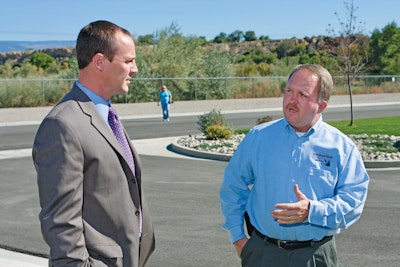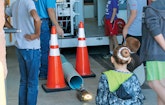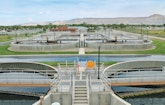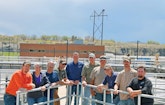
Matt Jones of the Clifton (Colorado) Sanitation District explains the secondary treatment process to a school group during a tour of the Clifton wastewater treatment plant.
In the early 1990s, two different districts managed wastewater in Clifton, Colorado, between them operating more than 20 miles of old clay and concrete sewer pipe, several lift stations and three separate lagoon systems discharging to the Colorado River.
Today, the districts have been consolidated into one, the lift stations are gone and much of the sewer system has been modernized and now flows by gravity to a beautifully landscaped 2.5 mgd biological nutrient removal facility that meets tightening requirements for ammonia, nitrogen and phosphorus removal. Dewatered biosolids are applied to the land.
The dramatic progress was the work of Brian Woods, recently retired as district manager.
“Brian Woods began working for the district in 1992,” explains Eli Jennings, the district’s operations manager. “He became district manager in 2005 and went to work on his vision for the district.”
The transformation began immediately. In 2005, one old section of sewer pipe was replaced with new 12- and 27-inch mainlines, and one lift station was taken out of service. The next year, Woods was instrumental in getting the two districts to consolidate into a single entity and starting the planning process for a new mechanical treatment facility.
By 2009, more mainline sewers had been installed and the new extended-air treatment plant and administration building were completed. The district abandoned the old lagoons and remediated their sites.
Thousands more feet of new gravity sewer lines were installed by 2014, and the final lift station was decommissioned. In 2015, the treatment plant was upgraded with anaerobic selectors for phosphorus removal; the final two interceptors were completed through the heart of the district in 2017-19.
Total cost of the projects on Woods’ watch totaled $39.6 million — nearly $6 million of that from 29 separate grants he applied for and obtained. The district’s debt is due to be retired by 2027.
“Everything that could be prepared for at the time, Brian has completed,” Jennings says. “His forethought and vision with each and every capital improvement project has allowed the district to always be prepared for development, replace critical infrastructure prior to failure, and coordinate with road replacement, upgrade or overlay projects.”
Doing it all
Clifton is located on the west slope of the Colorado Rockies, in the Grand Junction metropolitan area. The area’s economy is tied to oil and gas development in the area. The population is around 21,000, having tripled since 1990.
The Clifton Sanitation District is a self-supporting enterprise fund, providing wastewater services to both Clifton and the neighboring community of Whitewater.
While the district started with very limited operational staff — at times just one person — it has grown to nine full-time employees. “Brian hand-picked and trained the entire staff, establishing hiring practices, personnel manuals, rules and regulations, construction standards and specifications, and even the filing systems,” Jennings says.
The staff is responsible for both the sewer system and treatment plant. The crew uses a Rausch HD camera system (RauschUSA) to view sewer conditions. “It was one of the first to be used in the U.S. It has lateral launch capability as well.”
While the district owns a Vactor combination truck, it frequently uses an outside contractor for sewer cleaning. The company — Simon From Limon, owned and operated by Chris and Jess Solze — employs a unique system where swabs are pulled through the pipes with all debris removed at each manhole.
“It’s a good solution for roots,” Jennings says. “We clean as frequently as each quarter, and we use the outside contractor annually. But our maintenance system evolves based on where we need to clean and when.”
The district has replaced nearly half of the old clay and concrete pipe with new PVC and uses cured-in-place technology to remediate other sections.
“We plan to use CIPP on 22,000 feet of pipe this year,” he says. “It will be the largest single lining project to date and will address lines in all critical corridors and high-traffic roadways.
“We’re very impressed with trenchless technology. We find it creates a lower coefficient of friction in the pipe, and that reduces grease buildup.”
He says the remaining vitrified clay and concrete pipe in the district has been evaluated through an asset management program and will be phased out over the next five years. “That will finalize replacement, resizing and rehabilitation of the entire district.”
Because it is not tied to any specific community, the district’s wastewater staff is responsible for the engineering, planning and construction management along the collections system. “They do it all.”
Better treatment
At the treatment plant, the Clifton staff operates an oxidation ditch, secondary clarifier and UV disinfection system, with an average daily flow of around 1.25 mgd and organic loading of about 40% of capacity.
Using extended aeration, the facility achieves ammonia, nitrate/nitrite and phosphorus reductions in line with new state guidelines for discharge to the Colorado River.
Biosolids are aerobically digested and then dewatered on a centrifuge, as well as open-air drying beds in warm weather. Boisolids are beneficially reused on area farm fields.
“Once the new plant came online, Brian shifted the focus to establishing and maintaining a robust preventive maintenance program with redundancy of parts and adequate tools,” Jennings says. “We want to be as self-sufficient as possible and ensure the investment lasts as long as possible.”
The district also focused on the grounds around the plant, cognizant of the fact that it is located near neighborhoods, busy roads and public parks.
Jennings says some surrounding properties were purchased to establish the required setback and create a pleasant green space of sod, sprinkler systems and turf trees around the perimeter of the facility, as well as a 3-acre vineyard, a lavender field and six hayfields that are grazed by cattle.
Enjoying retirement
Today, nearly 30 years since he joined the district and 15 years since becoming district manager, Woods is enjoying retirement, comfortable knowing that the system he spearheaded is serving the community and protecting the water quality of the Colorado River.
That’s important because he fishes for trout in the river — just one of the many outdoor adventures he pursues.
Woods got into the clean-water profession after working in construction, with many projects related to wastewater including the Clifton collections system. He earned a degree in applied science in environmental restoration engineering technology and completed Colorado certification for both Wastewater A and Collections 4 licenses.
In an American Water Works Association member spotlight, Woods said he felt fortunate to have been part of the team consolidating the two districts and building a new treatment facility that is sustainable to the community and wildlife needs of the area.
Jennings calls his achievements “incredible.”
“For many years, he was the only person here. In addition to his accomplishments, he spent 10 years as a Clifton Volunteer Fire Department volunteer firefighter and EMT.”
Woods is more modest: “I think getting the two districts to consolidate into one and constructing the new treatment plant were two of our biggest achievements,” he says. “And our board was instrumental in those developments. They’ve been excellent, with several long-term board members.”
Woods says the improvements at Clifton have resulted in more consistent, sustainable water quality and that both operating like a business and good planning have kept rates low.
“The future here is extremely bright,” he says, noting that’s what he tells young people looking for a career. “Don’t overlook the clean-water profession. You can be a part of your community and the environment. It’s very rewarding.”









